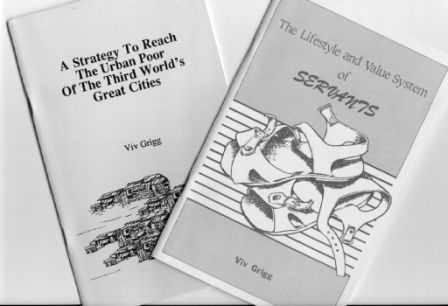
Urban Leadership Foundation
A hub for leadership training in cities and among the world's 1.4 billion slum-dwellers
 A monograph that has become the foundational document for the culture of several missions (Servant Partners, Servants to Asia's Urban Poor, Innerchange, Kairos...). Its 32 pages integrate the theology of the incarnation into values and practice for Protestant incarnational missions in the slums.
A monograph that has become the foundational document for the culture of several missions (Servant Partners, Servants to Asia's Urban Poor, Innerchange, Kairos...). Its 32 pages integrate the theology of the incarnation into values and practice for Protestant incarnational missions in the slums.
It defines 3 purposes, 4 Ministry Values and 8 Lifetyle Commitments:
Purposes: 1. Following Christ. 2. Knowing Christ through simplicity, incarnation, service, doing justice, preaching, community. 3. Establishing multiplying fellowships.
Ministry Values: 1. Evangelism and disciplemaking. 2. Service to the urban poor. 3. The power of the Holy Spirit. 4. Peacemaking, justice and development.
Lifestyle Values: 1. Incarnation. 2. Non-destitute poverty. 3. Inner simplicity 4. Spiritual disciplines 5. Responsible faith. 6 Fellowship of commitment. 7.Decision-making in Community. 8. Gifts of singleness, sacrifice in marriage.
Viv had been preaching, then living in the slums of Manila since the age of 24 - the only one in the slums among 4,000 missionaries in Manila. Following the incarnation of Christ seemed logical. From the age of ten he had read hundreds of missionary biographies from his home town library. Those missionaries that bore much fruit lived incarnationally. He wondered why there were no Protestants? Wondered why Catholic priests survived among the poor and Protestants did not survive?
He had been trained by the Navigators in disciple-making, and in Manila had already been involved in church-planting. He then studied community development at the University of the Philippines so had grappled ith how the incarnation results in social change. Simplicy, incarnation, communal decision-making, chosen singleness were learned from reading about the Catholic preaching friars. He was not constrained from drawing from Taize, Benedict and on the phraseology of other orders so the language at times is quaint.
In the heat of siesta hours, inspired by St Francis of Assissi and St Francis Xavier, he began to picture bands of men and women wandering across Asia, preaching the gospel, founding churches, multiplying movements, seeing slums transformed.
He wrote a parallel document - A Strategy to Reach the Slums of the Third World - but the core values behind this mission began to crystallize into three goals, four ministry values, and eight lifestyle commitments that would be the necessary commitments for the formation of a new type of Protestant order ...
SourcesNew paradigms are often the resullt of intuition. But there is another unproven idea out there that they result from 10,000 hours of mastering a field!! The incarnational lifestyle in the slums today might be called ethnography. The 10,000 hours of living there were matched with thousands of hours of reading since the age of nine of missionary biographies, then church growth materials. The corelation of engaging with a need for a new structure, and reflecting on the theology of incarnation and the literature on mission structures coalesced into a simple booklet in a graphical style.
This and some related publications on strategy generated a whole new wave of Western missions to the global slums.
Back in New Zealand a year later, he began to found the first mission. The initial mimeographed paper was peer tested with the incoming missionaries, then published in a graphical format. One of Viv's artist friends, part of the team in the slums did the graphic line drawings.
It become the core document of the mission, reveiwed yearly by all. It became the center of training of new workers. Within ten years it was revised by the workers, added to, modfied, but essentially the same.
A copy was published in Paul Pierson, Dean Emiritus of Fuller Theological Seminary's History of Missions course, so others began to copy the idea and develop their own Lifestyle and Values for their own missions... see for example the beautifully designed The Vision for Spirituality & Rule of Life of Servant-Partners, or Our Five Principles of Servants to Asia's Urban Poor. Others have created personal versions.
To Artifact #2: A book that defined the domain: Companion to the Poor
